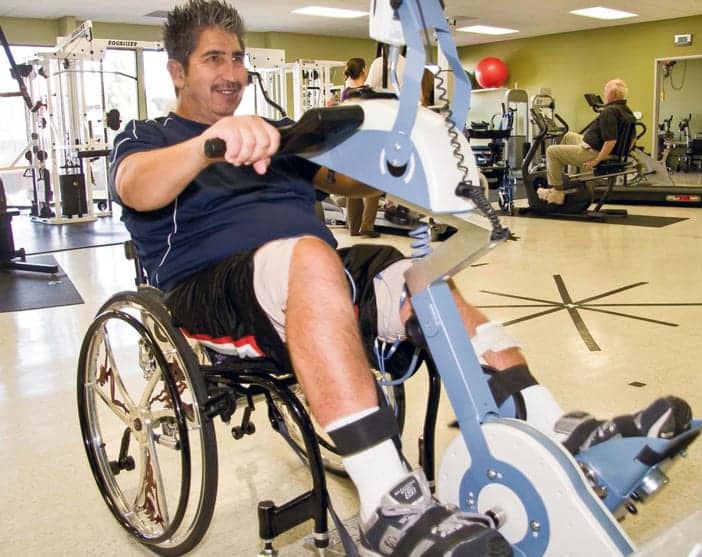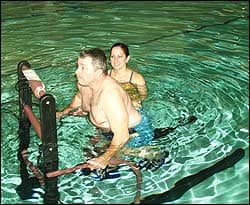A nonthreatening workout environment eases the transition from one-on-one therapy to self-managed and home-based exercise.
by Ziad Adel Dahdul, PT, DPT
 When a patient is dealing with an injury or ailment, the normal response on discharge day from therapy is excitement and relief. Why? Not because the patient dreaded going to therapy, or dealt with considerable pain in the rehabilitation process, but because that person has returned to the “prior level of function” and is ready to resume life as it was prior to injury. Not all individuals, however, feel the same about their therapy experience, and for some the end of therapy means the beginning of self-management—which can be a frightening thought.
When a patient is dealing with an injury or ailment, the normal response on discharge day from therapy is excitement and relief. Why? Not because the patient dreaded going to therapy, or dealt with considerable pain in the rehabilitation process, but because that person has returned to the “prior level of function” and is ready to resume life as it was prior to injury. Not all individuals, however, feel the same about their therapy experience, and for some the end of therapy means the beginning of self-management—which can be a frightening thought.
The patient population at Precision Rehabilitation is characterized by individuals who display courage and tenacity, as many of them deal with conditions that are chronic and life-altering in nature. As an outpatient neurologic/orthopedic facility, the clinic is visited by clients affected by neurologic diagnoses such as cerebrovascular accidents (CVA), spinal cord injuries (SCI), and traumatic brain injuries (TBI) in addition to orthopedic diagnoses such as total knee arthroplasties (TKA), adhesive capulitis, and sciatica. Because of the broad range of clients the clinic treats, the staff places a strong emphasis on providing a smooth transition from discharge to home exercise program to facilitate the continuance of care beyond one-on-one therapy.
When a patient is approaching discharge, that individual’s primary therapist begins to discuss “life after discharge,” offering a wealth of options to allow the individual to continue building on the gains made in therapy. These options include joining community fitness groups, signing up at a local gym, and/or attending support group sessions with community members.
Some clients find these options overwhelming because of the size of some of the programs, and the lack of assistance/accessibility. In those cases, we speak to clients about joining one of the many therapeutic classes offered at Precision Rehabilitation, all of which are guided by licensed physical therapists (PT).
One of the more popular programs offered is the Gym Program, provided to former clients as a way to continue working toward community and activity of daily living (ADL) related goals after discharge from skilled one-on-one therapy. This program is designed to provide a nonthreatening environment for patients to practice strength training, balance exercises, cardiovascular endurance training, and functional mobility training. Furthermore, clients have the opportunity to use equipment with which they are already familiar while surrounded by licensed physical therapists who can assist when needed. Some equipment available to clients who use this program include the following:
• Cross Trainer: This device provides a smooth and natural stepping motion that offers clients of all physical levels a total body workout.
• Cable System: A resistance training cable system allows for various upper and lower body strengthening, including lat pull downs, bicep curls, hamstring curls, and other therapeutic exercises.
• Active and Passive Lower Extremity Cycling Machine: This device uses motorized pedals to assist clients who cannot pedal independently while also allowing those who can pedal independently a resisted workout.
• Standing System: Designed to provide weight bearing and upright posture for individuals who could not maintain this position otherwise, this excellent device helps with muscle contractures and can be used on an independent basis.
• Exercise Machine: Functional training equipment that can be utilized by individuals of all levels allows the user to move anywhere from 3% to 72% of body weight through upper extremity or lower extremity motion. This equipment provides both strength and cardiovascular training and is user friendly with its mechanical height adjustment.
• Virtual Reality (VR) room: Our VR room is where the newest technology in video gaming is utilized for rehabilitative purposes. The gaming systems used offer utility for orthopedic, neurologic, and cardiovascular clients in a modified environment that promotes safety.
In addition to this specialized equipment, resistance bands, traditional cardiovascular machines (recumbent bike, upright bike, elliptical trainers, and treadmills), medicine balls, and free weights are also used. Another highlight of the program is the two large hi-lo mats available in the clinic, which make transferring to and from a wheelchair much easier and safer for clients who are more involved. Both of the large mat tables measure greater than 5 feet in diameter and can accommodate multiple clients at once, allowing for patient interaction and relationship development while working out.
The Gym Program is designed to be an independent program clients can use on their own (after their physical therapist determines they are safe for independent gym use and are trained on all the equipment) or with the help of a family member/caregiver.
However, for individuals who are looking for a more guided program conducted by a licensed physical therapist, other more specialized classes are available, including the following:
• Circuit Training class: This class is designed for clients who would like direction and assistance from a physical therapist to help them on/off equipment, watch for proper form and mechanics, and facilitate movement from station to station. In fact, each person’s circuit is devised from the patient’s therapy history and is individualized by their physical therapist. In addition, physical therapists use therapeutic strengthening principles as part of a circuit program to enhance strength and cardiovascular endurance by minimizing rest breaks and promoting constant work. This class is capped at five people and is conducted once each week.
• Parkinson’s LSVT BIG exercise class: This specifically designed program is made available to individuals who are affected by Parkinson’s disease or Parkinson’s-like symptoms. The program is staffed by a certified LSVT BIG physical therapist and LSVT LOUD speech therapist, each of whom is trained to provide interventions individualized for each patient. This program is appropriate for anyone, early through late stages of Parkinson’s, and also may include locomotor training (body-weight supported if necessary) in addition to balance training. The “BIG” exercise class is intended for individuals affected by Parkinson’s disease or similar symptoms, especially those who have completed the “BIG” program and have been advised to continue exercises in a group setting. This class is also capped at five people and is conducted once each week.
• Constraint Induced Movement Therapy (CIMT) program: CIMT is a program designed to promote increased use of an impaired arm after a neurologic injury, such as a stroke or brain injury. Studies have found that repetitive, task-oriented training, adherence-enhancing behavioral strategies (such as homework), and constraint have been effective in improving active use of an involved extremity regardless of how chronic the injury. Participants are engaged in CIMT 5 to 6 hours per day, 5 days per week, for 2 weeks, including physical therapy, occupational therapy, guided independent, and supervised activities at the clinic and at the home.
• Constraint Induced Movement Therapy class: An alternative and/or adjunct to our CIMT program, this weekly class follows the CIMT principles in a group environment that promotes increased use of the involved extremity in a much less intensive manner. Clients commonly take part in this class of post-stroke or brain injury rehabilitation as a way to continue receiving guidance about regaining function in the involved extremity after one-on-one therapy has culminated.
All of these programs are offered on a cash pay basis, as insurance companies traditionally do not cover services that are deemed “maintenance.” Program and class fees are designed to be affordable, and all, except for the CIMT program, are charged on a month-by-month basis. The CIMT class, which is an intensive 2-week program, is designed to have three cost-effective options to help accommodate anyone who is interested.
With all of the classes and programs, we have found that clients not only enjoy the continued guidance by therapists, but also benefit significantly from the accountability of being part of a weekly program. Individuals who have difficulty maintaining a consistent exercise program independently and are not self-motivators have been very successful in maintaining their current level of function and/or showing clinical gains beyond discharge from therapy. Also, clients thrive on the support and encouragement from our staff as well as from other members in each class who can empathize with each other’s condition.
Although classes do not offer one-on-one focus from a physical therapist at all times, the PTs who conduct these programs are trained to provide sufficient assistance and feedback to clients so that education is provided while simultaneously promoting patient independence. Also, support staff (students from accredited PT programs, aides, volunteers) are present who are trained to provide appropriate assistance should any of the therapists feel it is necessary.
The goal of these programs is to optimize clients’ physical performance and function by providing an evidence-based, nonthreatening environment for individuals of all levels. The scientifically based, therapeutic approach to rehabilitation these programs apply is embedded in all of the trained physical therapists who participate in the programs. Team members pride themselves on providing the best treatment possible to all clients while assuring those clients will be able to continue and maintain the levels of function they have achieved, even after formal discharge from therapy. RM
Ziad Adel Dahdul, PT, DPT, is a physical therapist at Precision Rehabilitation, an outpatient neurologic/orthopedic facility in Long Beach, Calif. He received his clinical doctorate in physical therapy from the University of Southern California in 2010. Dahdul specializes in orthopedic physical therapy across the life-span and has experience treating musculoskeletal disorders in the neurologic population. He has been a clinical instructor for physical therapy students across Southern California. For more information, contact [email protected].



